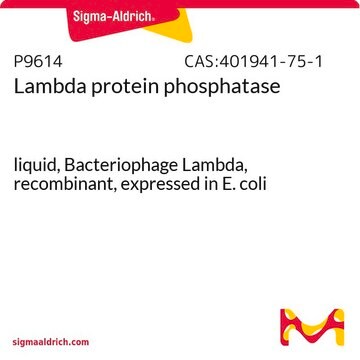P6244
Protein Tyrosine Phosphatase 1B human
recombinant, expressed in E. coli
Synonym(s):
PTP-1B
Sign Into View Organizational & Contract Pricing
All Photos(1)
About This Item
Recommended Products
recombinant
expressed in E. coli
Quality Level
form
solution
specific activity
≥20 units/mg protein
mol wt
37.4 kDa
concentration
≥0.5 mg/mL
UniProt accession no.
relevant disease(s)
diabetes; obesity; cancer
shipped in
dry ice
storage temp.
−70°C
Gene Information
human ... PTPN1(5770)
Looking for similar products? Visit Product Comparison Guide
General description
Protein tyrosine phosphatase 1B human (PTP1B) is encoded by the gene PTPN1. In human chromosome, the gene PTPN1 is localized on 20q13.13. The protein has 37 kDa catalytic domain and the C-terminal hydrophobic residues targets the protein to the cytoplasmic side of the endoplasmic reticulum membrane.
Application
Protein Tyrosine Phosphatase 1B (PTP1B) human has been used in treating cell lysate prior to immunoprecipitation and protein pull-down studies. It has also been used in PTP1B activity assay and also for the evaluation of inhibitors like betulinic acid (BA) and sodium orthovanadate (Na3VO4), and 6-chloro-3-formyl-7-methylchromone (CFM) on PTP1B.
Protein tyrosine phosphatase 1B (PTP1B) is a pharmaceutical target used to study the treatment of various diseases such as obesity, cancer and type II diabetes mellitus.
The inhibitory effect of 8-(4-chlorophenylthio)-cAMP and 8-(4-chlorophenylthio)-cGMP on protein tyrosine phosphatase-1B has been assayed.
Biochem/physiol Actions
PTP-1B is a recombinant, non-transmembrane protein expressed in E. coli containing amino acid residues 1-322 of human PTP-1B. It has a molecular mass of 37.4 kDa. It is an abundant intracellular enzyme that is thought to act as a negative regulator of certain signaling pathways. It dephosphorylates tyrosine-phosphorylated proteins and peptides, and is usually localized in the cytostolic domain of the ER.
PTP1B dephosphorylates c-Src in several human breast cancer cell lines has a regulatory role for PTP1B in the control of c-Src kinase activity. PTP1B is regulates the cardiovascular effects of leptin. PTP1B controls the JAK/STAT signaling pathway by dephosphorylation of JAK2.
Polymorphism in the gene PTPN1 is associated with type 2 diabetes and obesity.
Unit Definition
One unit will hydrolyze 1.0 μmole of a phosphopeptide, EGFR fragment 988-998, per minute at pH 7.2 at 30 °C
Physical form
Supplied as a solution in 50 mM HEPES (pH 7.2), 1 mM EDTA, 5 mM DTT, and 0.05% NP-40
Storage Class Code
12 - Non Combustible Liquids
WGK
WGK 1
Flash Point(F)
Not applicable
Flash Point(C)
Not applicable
Certificates of Analysis (COA)
Search for Certificates of Analysis (COA) by entering the products Lot/Batch Number. Lot and Batch Numbers can be found on a product’s label following the words ‘Lot’ or ‘Batch’.
Already Own This Product?
Find documentation for the products that you have recently purchased in the Document Library.
Customers Also Viewed
Analysis of common PTPN1 gene variants in type 2 diabetes, obesity and associated phenotypes in the French population
Cheyssac C, et al.
BMC Medical Genetics, 7(1), 44-44 (2006)
p66Shc couples mechanical signals to RhoA through FAK-dependent recruitment of p115-RhoGEF and GEF-H1
Wu RF, et al.
Molecular and Cellular Biology, MCB-00194 (2016)
Shaowei Wang et al.
Frontiers in microbiology, 12, 715773-715773 (2021-08-03)
Human PTEN, a dual-phosphatase tumor suppressor, is frequently dysregulated by alternative splicing. Fungi harbor PTEN homologs, but alternative splicing of fungal PTENs has not been reported as far as we know. Here, we described an alternative splicing case in the
PTP1B: from the sidelines to the front lines!
Tonks NK
Febs Letters, 546(1), 140-148 (2003)
p66Shc couples mechanical signals to RhoA through FAK-dependent recruitment of p115-RhoGEF and GEF-H1
Wu RF, et al.
Molecular and cellular biology, MCB-00194 (2016)
Our team of scientists has experience in all areas of research including Life Science, Material Science, Chemical Synthesis, Chromatography, Analytical and many others.
Contact Technical Service











